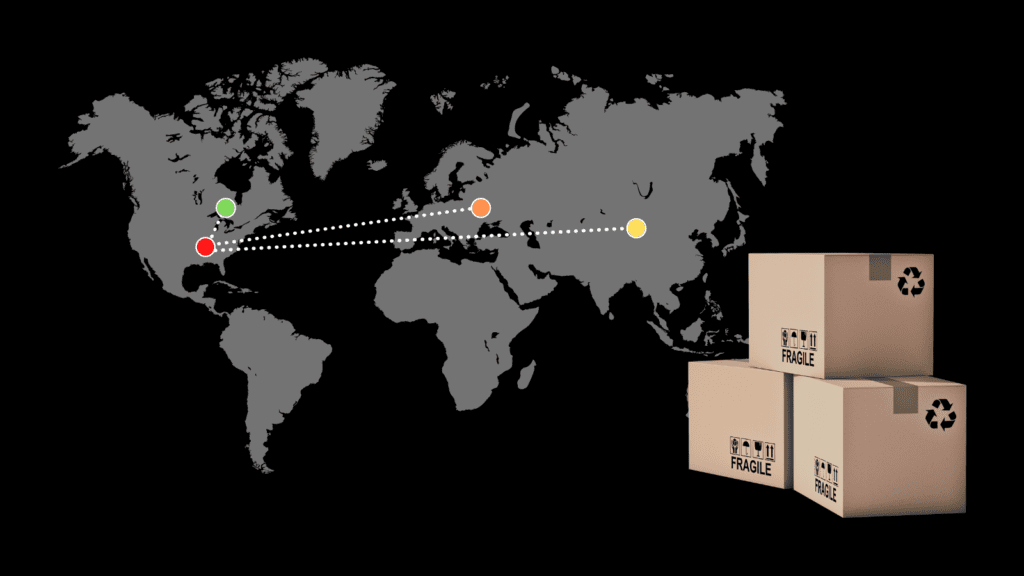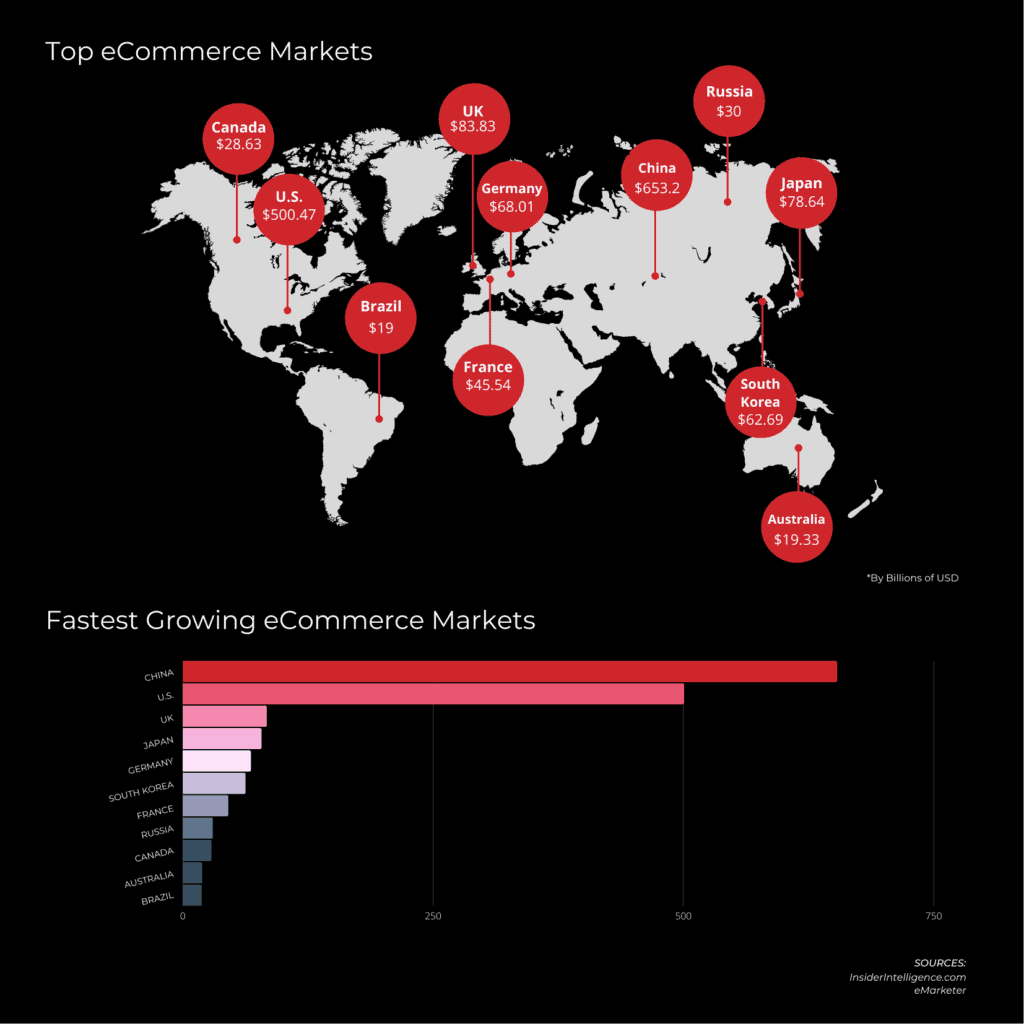Many U.S. eCommerce retailers only sell to U.S. customers. If you only ship within the U.S., you could be missing out on a terrific growth opportunity in international eCommerce. ECommerce is king in South Korea and China. In fact, China’s eCommerce market, the biggest in the world, is almost double the U.S. And Alibaba’s online shopping holiday, Singles Day, delivered a record $74.1 billion in revenue in 2020, compared to $11.2 billion for Amazon Prime Day 2020.

Plenty of Chinese businesses have found a way to sell to U.S. consumers and ship those orders cheaply and quickly. The challenge for U.S. businesses that want to break into markets in Asia, and also in Europe, Australia, and South America, is to find a way to deliver the same great service to international customers that they offer domestically.
The internet has made cross-border communication instantaneous, so taking orders is no problem. However, you will still have some hurdles to overcome if you want to expand your eCommerce business internationally, such as establishing eCommerce fulfillment services to reach your major international markets. Here is your ultimate guide to expanding your eCommerce business internationally.
- Opportunities and Challenges of Expanding Your ECommerce Business Internationally
- A Shortcut for Expanding into International ECommerce
- Where Is this Growth Happening?
- Is Your eCommerce Business Ready to Go Global?
- Questions to Ask Yourself Before Expanding into International ECommerce
- Understanding the Challenges of Expanding Your eCommerce Business Internationally
- Top Tips to Build an International eCommerce Business
- Expand Locally, Sell Globally
Opportunities and Challenges of Expanding Your ECommerce Business Internationally
International eCommerce sales are expected to total almost $5 trillion in 2021. While eCommerce as a share of retail has been on a steady upward trend, the pandemic pushed that growth far beyond predictions. Worldwide, eCommerce sales grew by more than 25% in 2020, and 2021 should be another year of stellar growth.
If you want to tap into the global potential of your eCommerce business, you’ll need to invest in some additional infrastructure to facilitate international sales. However, you don’t have to take on the world all at once.
Your international growth can be organic. For example, you might want to start with one country and expand incrementally. Once you have mastered the challenges of selling internationally in one country (and reaped the rewards, in higher profits), you’ll be better prepared to take your eCommerce business to other cross-border markets.

A Shortcut for Expanding into International ECommerce
If you don’t have the resources to build separate websites for different countries, you can still expand your eCommerce business on a global scale. Amazon, eBay, Newegg, Walmart Marketplace, and Etsy are just a few of the eCommerce platforms that offer U.S. sellers the opportunity to connect with international buyers. You can also work with marketplaces based outside the U.S., such as Alibaba (China’s online retail giant) or its international offshoot AliExpress; Mercado Libre (the largest eCommerce site in Latin America), or Flipkart (the second biggest player in eCommerce in India, after Amazon), to name just a few.
Etsy reported that one seller got almost a fifth of her sales from overseas the year after she started offering international shipping. When you sell on marketplaces such as Etsy and eBay, all you have to do to become an international seller is offer international shipping in your shop. In most cases, you can decide which countries you will ship to. That will allow you to try out a few international sales before you add more countries to your repertoire.
You can offer your products for sale on some of the many international eCommerce marketplaces, based in the U.S. and other countries. There are lists of international eCommerce sites online, and they are worth considering as part of your research and planning for taking your eCommerce business international.
Where Is this Growth Happening?
China presents the biggest opportunity for U.S. eCommerce businesses to expand internationally, but it may not be the easiest market for U.S.-based companies to break into. U.S. sellers have to contend with price competition and knockoffs in the Chinese market. And the cost of shipping and long delivery times can be a barrier for Chinese customers. Fulfillment to Asia can be a tough hurdle to overcome when you first expand your eCommerce business internationally.

Because of the distance from the U.S., plus the added difficulty of language and cultural barriers, China’s huge eCommerce market might not be the first stop on your route to global eCommerce expansion.
Consider starting with a country that’s easier to ship to and has fewer language and cultural barriers. For example, the UK has the third biggest eCommerce market, with $83.83 billion in annual sales. Germany, and France all have robust eCommerce markets that could be good expansion targets. Japan, South Korea, Russia, and Brazil are also among the top markets for eCommerce sellers.
And don’t forget Canada, which is one of the easiest places for U.S. eCommerce businesses to start an international eCommerce expansion, because of proximity, cultural similarities, and the ease of cross-border trade. Canada represents an online market of almost $30 billion that U.S. sellers should put at the top of their lists for global online sales.
Is Your eCommerce Business Ready to Go Global?
Not every U.S. eCommerce business will do well in international markets. It’s important to consider the competition and the demand for your product category in various countries before deciding where and how to expand.
You will also have to resolve questions about logistics before you invest in a new international sales channel. Plus, you’ll need to make a business decision about whether you have the resources you need to serve this new market.
Questions to Ask Yourself Before Expanding into International ECommerce
Here are some questions to help you determine whether your eCommerce business is ready to expand internationally.
Will your product sell in another country?
Before you invest in a new website and branding to appeal to, for example, German customers, do the research to determine if your product will sell in the German eCommerce market.
You will have to answer some questions by trial and error, and the fact that there are no comparable products in a market could be an opportunity rather than a red flag. Whatever your approach, you can eliminate a lot of uncertainty and save yourself money by doing research and understanding your new market before you dive in.
Can you ship it?
International shipping can be both expensive and slow at times. Shipping costs, in particular, are a deterrent for online shoppers in many countries.
Some eCommerce businesses choose to work with local shippers and warehouse products in national fulfillment centers close to their customers.. A distributed inventory management strategy allows for shorter shipping times and lower shipping costs for consumers. As you expand your eCommerce business internationally, international fulfillment locations may make sense for you.
In the beginning, however, you will probably continue to work with your existing fulfillment partner while you test the market. Find out which international shipper offers the most reliable, fastest, and least expensive service to your new markets and make sure your 3PL company can manage your international shipping.
Don’t assume that high shipping costs are an insurmountable barrier to your entry into international eCommerce. If your product is unusual or hard to find in another country, customers may be happy to pay more for shipping and wait patiently to get your items. Their reward will be receiving a product they can’t get closer to home.
What is the market for your products abroad?
If you sell floral beach coverups, are they too bright for Northern Europeans or do you offer a splash of color they crave? Can you translate your sizing so South Korean customers aren’t disappointed by getting something that doesn’t fit? Is the market for your product already saturated? Or is no one selling a product like yours in Brazil because Brazilians won’t buy it?

If there isn’t yet a market for your products in another country, you could be a pioneer and own the niche for your items. That will probably require an investment of marketing dollars to educate your new customers and raise awareness. Before taking on the task of introducing your items to a brand new market, decide whether you can afford the upfront investment. After all, there is a risk of failure if the residents of the other country never warm to your product.
Can you build cultural fluency?
Another consideration is cultural sensitivity. Cultural references and jokes may not translate or may be taken very differently abroad than in the U.S. Or a product that residents of one country find indispensable could seem frivolous and wasteful to those in another.
Do you have the right technology?
You may need to make some technical changes to your eCommerce site to be compatible with sales to a foreign market. That could include expanding the types of payment you accept to include the preferred methods in of your new customers.
Another important aspect of going global, especially if you want to expand into developing nations like India and South Africa, is creating a mobile-friendly site. Mobile shopping has been on the rise worldwide, but mobile phone use rates are particularly high in the developing world, so your customers are more likely to have internet access through a smartphone than a computer.
Can your operations handle international eCommerce?
Before you make the leap into international eCommerce expansion, consider whether your operations team can put the systems in place to handle the needs of international customers. Your customer service should be ready to respond in the customers’ time zone and language if different from yours.

You should also make a plan to support the marketing channels you’ll need to reach cross-border customers. Your marketing team will need to be prepared to handle the extra work that comes with this international expansion.
It’s a good idea to create a separate web portal and social media accounts for each international market, plus ad buys that target your international customers.
Do you have a plan to deal with fraud?
All eCommerce businesses have to build trust with their customers. Trust is particularly important in cross-border eCommerce transactions, because of the distance between the parties. You need to assure your customers that your business is legitimate and that you will deliver what you promise.
But fraud can go two ways, so you also need to confirm that your customers are legitimate. Before you expand your eCommerce business internationally, put systems in place to verify that international shipping addresses are genuine. That will allow you to avoid potential fraud, which can cost your business.
If you’re ready to take your eCommerce business international, you open yourself to a huge growth opportunity. Not only do you gain access to a world of customers; you also build international relationships that can enrich your business. The cross-border cross-pollination of ideas and resources could lead to business opportunities you haven’t yet imagined.
If you feel that your eCommerce business has the resources on hand to take on the international marketplace, there are still a few more challenges to be aware of before you get started.
Understanding the Challenges of Expanding Your eCommerce Business Internationally
Expanding your eCommerce business internationally can be as simple as offering international shipping in your eBay store. But if you’re serious about connecting with customers in other countries and building an international following, you’ll need to do more to reach out to your cross-border market.
Here are some of the challenges to consider as you grow your global eCommerce empire.
Duties and taxes
You’ll need to understand the taxes you need to collect on sales to different countries. For example, sales to the UK must include that country’s VAT tax in the price. It’s the opposite of the U.S., where many states don’t allow retailers to list prices that include sales tax.
Some countries charge a duty when you ship orders over a certain dollar amount, and you may need to fill out customs forms for your orders. Find out if your order fulfillment provider can take care of customs paperwork for you.
Language
Google Translate is pretty good, but you’ll need to do better if you want web pages that read well in the language of your target customers. Work with translators fluent not only in the language but the culture and idioms of the residents of your target country.
Local customs
Even if you stick to markets that speak English, you’ll need to make sure your online sales pages speak to your audience in each country. It’s important to avoid words or images that might be offensive to local sensibilities. Work with a marketing team in your international target market to help you create culturally sensitive sales materials.
Payment options
You’ll want to expand the types of payment you accept to include the preferred methods for each country you sell into. PayPal, Stripe, and Apple Pay have international reach, but you could lose sales if you don’t include your customers’ favorite options, such as Alipay and UnionPay (China), Mercado Pago (Latin America), WorldPay (Latin America, Europe), and Skrill and SEPA (Europe).

Local currencies
Many online payment methods will allow customers to pay you in U.S. dollars. However, confusion about your pricing could slow your international growth. You’ll increase your sales when you translate your prices into local currencies and accept payment in those currencies. Plus, if you want your business to fit in with local customs, pricing your products in the local currency will help you sell like a native.
Shipping options
As you prepare to sell internationally, set up accounts with carriers that best serve your target markets overseas. FedEx and UPS both offer international shipping, as does the U.S. Postal Service. German-based DHL has long been a leader in cross-border freight. The best choice is a delivery service that has the best penetration and most reliable service in the country you plan to sell to.

Customer service
If your customer service hours are 8:00 am to 5:00 pm in Boise, you’ll miss calls from Beijing or Brussels. Consider using a call center in the time zone of the country it serves. It’s also a good idea to use agents who speak that country’s language.
Providing customer service that’s responsive to international time zones, languages, and cultural expectations will get you positive reviews. And it will help your eCommerce business grow faster in international markets.
Returns
International customers will need to make returns, too. You’ll need to set up a system that allows customers to make and track cross-border returns and provide timely refunds.

Visibility
One of the biggest challenges when you expand your eCommerce business internationally may be learning how to make your eCommerce site visible in a variety of markets. This could also be one of the most fun and rewarding pieces of your international eCommerce expansion. Consider partnering with local marketing experts to improve your reach in your expansion regions.
The list of challenges can feel long. But ask yourself where you want your business to be in five or 10 years. Do you want to plod along with incremental growth? Or do you see yourself presiding over a thriving, international eCommerce enterprise? If it’s the latter, there’s no better time to start than now.
Top Tips to Build an International eCommerce Business
Here are four things that will put you on the right path to expanding your eCommerce business internationally. A little legwork up front will save you expensive headaches down the line.
1. Research, Research, Research
Once you’re ready to expand your eCommerce business internationally, your first step is research. This will help you figure out where it makes sense to expand and how to introduce your product to a new market.
Research which country might be most receptive to your products. You might be surprised by what you find out. Your best opportunities will be in countries with small, but growing niches for the goods you sell. Great tools for assessing market opportunities include Google Trends and Answer the Public.
You can also find tools to help you learn the ropes of selling internationally at the U.S. Small Business Administration.
Your research should lead you to the best country or countries for your entry into international eCommerce. Learn as much as possible about your new market. Find out if there are certain cities or regions most suited to your initial launch. Make a list of national holidays and customs. Tailor your web presence and your message to your new customer base. This could include rebranding or repositioning some of your products for that country.
2. Plan Your Market Entry
Your eCommerce expansion will go better if you take the time to plan it out. Make sure that you have all the pieces in place, such as payment methods for the local market. Optimize your website for mobile. Have your customer service team ready to spring into action when needed.
3. Plan Your Logistics
Work with your 3PL services provider to make sure your international shipping options are ready to go as soon as the orders roll in. This includes putting a plan in place so you can handle international returns without busting your profit margin.

4. Optimize Your Marketing Strategies
Social media that speaks to customers in your new market is an effective, inexpensive way to reach your new audience. Consider partnering with local consultants to make sure your message matches your market. Don’t be afraid to let your new customers know where you’re from if that adds to the appeal of your eCommerce business. However, make sure you speak to them with a perspective that they will understand and appreciate.
Expand Locally, Sell Globally
You may hit some bumps in the road when you’re expanding your eCommerce business internationally. However, the opportunities for additional revenue make this a worthwhile project for eCommerce businesses. Plus, as shipping, payment, and communications channels become more globalized each year, international eCommerce becomes easier for sellers and consumers.
By starting now, you can establish yourself in international markets while the opportunities to grow and compete are still large.
More about international eCommerce:
- Global Order Fulfillment Strategies
- From Suez to Seattle, Global Bottlenecks Remain an Ongoing Threat to ECommerce Logistics
- What’s Your Plan for North American Fulfillment?










